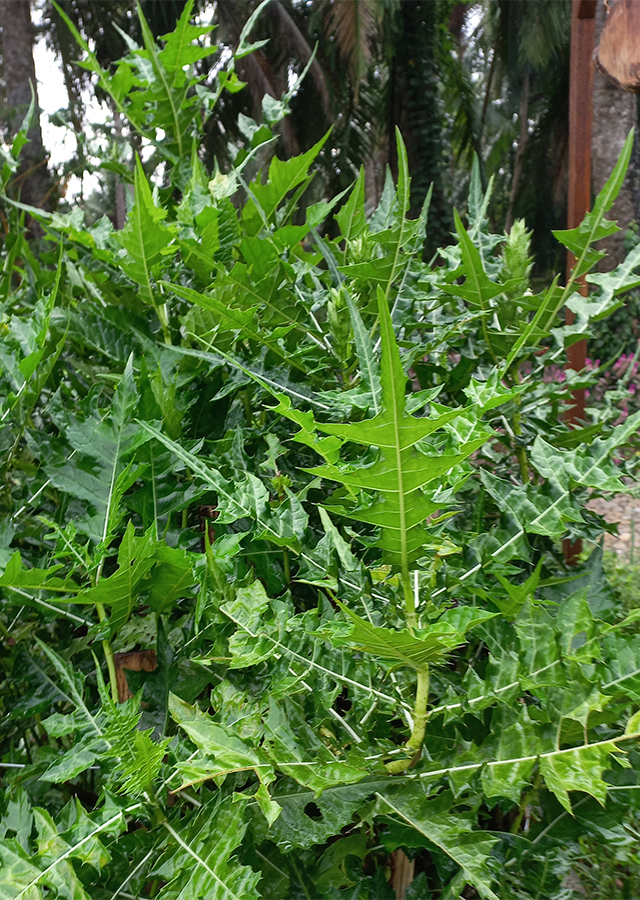Traditional Herbs from Acanthus montanus
hepatitis
- Prepare 100 g\u00a0dry roots of blue flower.
- Boil with 2 glasses of water until remaining 1\/2 glasses.
- Leave it to cool.
- Strain and divide into 2 glasses ( 1\/4 cup).
- Add 1 tbsp honey.
- Drink.
boil
- Take enough blue flower daruju leaves\u00a0.
- Wash thoroughly with water flowing.
- Blend it until it becomes a paste.
- Apply the paste to the\u00a0boil.
What is Acanthus montanus Looks like??



Parts of Acanthus montanus that could be used
- Leaves
- Roots
Acanthus montanus Distribution
Blue flower daruju is often referred to as 'mountain thistle' or 'alligator plant' because of the shape of its leaves. This plant originates from Angola, Benin, Cameroon, Central African Republic, Congo, Equatorial Guinea, Gabon, Ghana, Niger, and Togo. This plant is also reported as one of the threatened and underused vegetable species in Africa. Apart from being used as an ornamental plant, this plant can be used in making soup because it is considered to have many nutrients. In traditional medicine, this vegetable decoction/stew is used for various therapeutic purposes such as managing diabetes, used in the treatment of body aches and pains, coughs, inflammatory/infectious diseases, coughs, and others.Agroecology of Acanthus montanus
Daruju blue flowers can grow in fertile, moist and well-drained soil, as well as in full sun. The plant tolerates a wide range of soils except those that are poorly drained. Plants may not flower well in too shady areas. Remove the flower stalks after they bloom. The plant can spread invasively by creeping lower stems, especially in loose soil.
Morphology of Acanthus montanus
- Stems wet upright, heavily branched, smooth bark.
- Leaves single, ovate to lanceolate, shallow to deep lobed, toothed with short spines, pointed tip, dark glossy green above and pale green below.", "Flowers\u00a0at stem tips, two-lipped, blue, pink to reddish in long erect spikes.
Cultivation of Acanthus montanus
The plant is best propagated from root cuttings taken at the start of the rainy season, but can also be grown from seed.
Acanthus montanus, more details :
Chemical Content of Acanthus montanusAlkaloids, flavonoids, glycosides, steroids, saponins, tannins, terpenoids, (2,6-bis(1,1-dimethylethyl)-4-methyl phenol), allyl(2-tetrahydrofuryl methoxy)dimethylsilane, sulfuric acid cyclohexylmethyl hexyl ester, alpha -methyl 4- methylmannoside, hexadecanoic acid methyl ester, acid methyl ester 11-octadecenoate, docosane, N,N-dimethylvaleramide, 2,6,10,15-tetramethyl heptadecane, β- sitosterol-3-O-β–D-glucoside, palmitic acid, linaroside, homoplantagenin, 5, 7, 3 - trihydroxy-6,4′ -dimethoxy flavone-7-O-glucoside, shikimic acid, protocathetic acid, blefarin, and acetoside.
Benefits of Acanthus montanus
Treatment of gonorrhea, syphilis, wounds, boils, hypertension, heart dysfunction, hepatitis, vomiting in children, coughs, epilepsy, laxatives and abscesses. Has antimicrobial, antidiabetic, anti-inflammatory, analgesic, immunomodulatory, hepatoprotective, antifertility, fetotoxic, relaxant, anthelmintic, anti-mosquito activity.
Simplisia of Acanthus montanus
- Prepare fresh roots of blue flower,\u00a0wash thoroughly with running water\u00a0then drain.
- Dry in direct sunlight for several days or in an oven at a temperature\u00a040 \u00b0C until the moisture content\u00a010%.
- Store\u00a0simplicia in a clean, airtight container.
Another Facts for Acanthus montanus :
Synonym of Acanthus montanusAcanthus barteri T. Anderson, Cheilopsis montana Nees
Habitus of Acanthus montanus
Bush. Annual shrub, up to 2 m high
Habitat of Acanthus montanus
- Coast
- Grassland
No comments:
Post a Comment